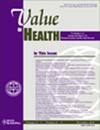The Cost-Effectiveness of Frontline Tyrosine Kinase Inhibitors for Patients With Chronic Myeloid Leukemia: In Pursuit of Treatment-Free Remission and Dose Reduction
IF 4.9
2区 医学
Q1 ECONOMICS
引用次数: 0
Abstract
Objectives
The management of chronic myeloid leukemia (CML) now includes dose reduction (DR) and treatment-free remission (TFR). Evaluating the cost-effectiveness of lifelong-prescribed expensive tyrosine kinase inhibitors (TKIs) for CML is crucial. Prior cost-effectiveness evaluations state that imatinib is the favorable frontline TKI. Some of these evaluations address TFR, but not DR, nor aging and second-generation (2G)-TKIs upcoming patent expirations. This study evaluates the cost-effectiveness of frontline TKIs for CML patients including these factors.
Methods
This Markov model evaluates the cost-effectiveness of frontline TKIs for newly diagnosed patients with CML using 17 health states. Transition probabilities, costs, and utilities were derived from literature data. Incremental cost-effectiveness ratios were calculated. Sensitivity analysis and model validation were conducted.
Results
Nilotinib is most effective (20.13 quality-adjusted life-years [QALYs]) and imatinib is least effective (17.25 QALYs) for the model including TFR and DR. Imatinib was favored over dasatinib (89.80%), nilotinib (62.70%), and bosutinib (78.40%), at a willingness-to-pay threshold of €80 000 per QALY. Without TFR and DR, fewer QALYs were generated. For patients at the age of 70 years, imatinib has a high probability of being more cost-effective than dasatinib, nilotinib, and bosutinib. With 50% 2GTKI cost reductions, nilotinib is considered more cost-effective compared with imatinib (98.40%), dasatinib (94.80%), and bosutinib (68.90%).
Conclusions
The findings indicate that 2GTKIs are more effective in generating QALYs, including for older (age >70 years) patients. Given the current TKI prices, imatinib remains cost-effective. Including DR and TFR in CML management generates more QALYs. Cost reductions from expected 2GTKIs patent expirations will greatly increase their cost-effectiveness. Results may inform 2GTKIs cost discussions after patent expiration, potentially broadening global availability. The findings also emphasize the importance of aiming for TFR and DR in CML management.
慢性髓系白血病患者一线TKI策略的成本-效果:追求无治疗缓解和剂量减少。
目的:慢性髓性白血病(CML)的治疗现在包括剂量减少(DR)和无治疗缓解(TFR)。评估终身处方昂贵的酪氨酸激酶抑制剂(TKIs)治疗CML的成本效益至关重要。先前的成本效益评估表明,伊马替尼是有利的一线TKI。其中一些评估涉及TFR,但不涉及DR,也不涉及老化和即将到期的第二代(2G) tki。本研究评估了包括这些因素在内的一线tki治疗CML患者的成本效益。方法:采用马尔可夫模型评估17种健康状态下一线tki治疗新诊断CML患者的成本-效果。转换概率、成本和效用来源于文献数据。计算增量成本-效果比。进行敏感性分析和模型验证。结果:在包括TFR和dr的模型中,尼洛替尼最有效(20.13 QALYs),伊马替尼最无效(17.25 QALYs),伊马替尼优于达沙替尼(89.80%)、尼洛替尼(62.70%)和博舒替尼(78.40%),WTP为80,000欧元/QALY。没有TFR和DR,产生的qaly较少。对于70岁的患者,与达沙替尼、尼洛替尼和博舒替尼相比,伊马替尼具有较高的成本效益。尼罗替尼的2GTKI成本降低了50%,与伊马替尼(98.40%)、达沙替尼(94.80%)和博舒替尼(68.90%)相比,尼罗替尼被认为具有成本效益。结论:研究结果表明,2GTKIs在产生QALYs方面更有效,包括老年(70岁)患者。考虑到目前TKI的价格,伊马替尼仍然具有成本效益。在cml管理中加入DR和TFR可以产生更多的qaly。从预计的2个gtki专利到期中减少的成本将大大提高其成本效益。研究结果可能会在专利到期后为2gtki的成本讨论提供信息,从而有可能扩大其在全球的可用性。研究结果还强调了在cml管理中以TFR和DR为目标的重要性。
本文章由计算机程序翻译,如有差异,请以英文原文为准。
求助全文
约1分钟内获得全文
求助全文
来源期刊

Value in Health
医学-卫生保健
CiteScore
6.90
自引率
6.70%
发文量
3064
审稿时长
3-8 weeks
期刊介绍:
Value in Health contains original research articles for pharmacoeconomics, health economics, and outcomes research (clinical, economic, and patient-reported outcomes/preference-based research), as well as conceptual and health policy articles that provide valuable information for health care decision-makers as well as the research community. As the official journal of ISPOR, Value in Health provides a forum for researchers, as well as health care decision-makers to translate outcomes research into health care decisions.
 求助内容:
求助内容: 应助结果提醒方式:
应助结果提醒方式:


